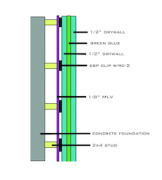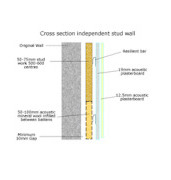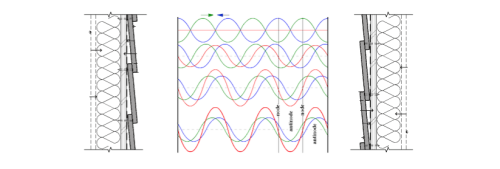Foo Fighters frontman Dave Grohl has written a letter in support of a teenage band that was banned by city council.
 To learn more about Black Leaves of Envy & how you can help the Cornwall campaign to provide all young musicians with a communal practice space, please contact Mr. Plenty at scoobsplenty@hotmail.com
To learn more about Black Leaves of Envy & how you can help the Cornwall campaign to provide all young musicians with a communal practice space, please contact Mr. Plenty at scoobsplenty@hotmail.com
To learn more about how to sound proof YOUR practice space, we’ve put together some info for you here: http://foofighters.com/soundproofing
Hello Black Leaves of Envy,
I read the news story and watched your great video and in it could see glimpses of your garage practice space. With its block walls, concrete floor, open ceiling and roll up door it is like a perfect speaker box for projecting your music to the distant neighbors, they should be grateful, but since they are not, here is a few things you can do help quiet down whats getting outside.
- The biggest change you could make would be to fill the block walls with sand, this would help trap some of the lowest sub frequencies that travel the farthest. With the ceiling open you could get easy access to the top of the blocks and then literally pour in sand until they are full.
- Cover the ceiling, 2 layers of drywall would help a lot but anything you can find will make it better, plywood, house siding, etc, as many layers as you can.
- Fill large garbage bags with blankets, clothes, old socks, packing peanuts most anything, dense and fibrous is best. Stack these on top of each other in the every corner of the garage, floor to ceiling, they will act as corner traps and help with low frequencies that build up in the room.
- Add mass to the roll up door. This could even be leaning sheets of plywood and mattresses against it.
- Add mass to the walls, hanging blankets, carpets, mattresses everything you can find, the thicker it is the lower frequencies it traps.
- Cover the floor in rubberized material, carpet pads, gym mats, rubber back entry mats.
If you are interested in more about Sound Proofing and Sound Treatment here are some of the basic principals and materials used.
There are 4 primary ways to soundproof.
Add Mass or Density
Many ways to do this, using concrete board, drywall, mass loaded vinyl, plywood, sand etc.
The most common way is to add another layer of drywall over the rooms existing drywall, the soundboard and drywall combination gets great results as well. For major reductions you might have to layer some concrete board and mass loaded vinyl.
Dampening
Damping means to reduce resonance in the room, by absorption or redirection (reflection or diffusion).This is commonly done with various kinds of insulation, Rockwool and semi rigid fiberglass being the most common.
Sound Board, Sound Board, Sound Board… or as it is also called, Fiber Board, is a rigid panel produced from non-toxic organic material and natural wood fibers that are wax impregnated which is lightweight, cost efficient and easy to install, this stuff is your best friend for tonally tightening up your space and quieting things down, made by many manufacturers and sold at most hardware stores, usually runs $10-12 bucks for a 4’x8’ Sheet. you can glue it, screw it or nail it to just about anything, stack it or arrange it to deal with different frequencies, it is not a cure all but is one of the best bang for your buck in sound treatment.
Decoupling
Decoupling means mechanically separating the two sides of a wall to make it harder for sound to pass through the wall. This is can be done by building double walls or with rubber boots and pads to set walls and joists on. Resilient channel can be used to add space and separate contact between wall or ceiling panels. Any material with and air gap between them (decoupled) will stop more sound transfer than the same material making contact.
Filling Air Gaps
Which is pretty self explanatory, caulk everything! As well weather stripping and foam seals work great around windows and doors.
Here are some examples of wall sound proofing treatments.
Sound Treatment
When it comes to treatment of a room there is a common equation of 30%, 30%, 40%, which means, 30% absorption, 30% diffusion and leave the rest in its natural reflective state. This works good for recording studios but when it comes to the rehearsal space or jam room you may need to over compensate in some areas as these are rarely rooms designed for sound and usually have many unique sound traits.
Spectrum Analyzing
Before you start it helps to know what you are dealing with. this has become easily accessed technology. From your smart phone you can generate Pink noise or individual tones to run through your PA system, as well there are some good spectrum analysis apps that will be calibrated to your specific phone. Neither of these will be perfect but are a cheap and easy way to get a good idea where the problematic sonic issues are in your room.
Corner Traps
Lets start with the most common scenario. You have a square or rectangle room that sounds boomy or cloudy when you play. Low frequency energy will build up in the corners of the room, to clean this up you need some bass traps. A simple way to apply this is get 8 large bags of denim insulation and stack the on top of each other, 2 in each corner. Use twine and screws to keep them tight in the corner, hang a blanket in front if you want. You will be amazed how much this will tighten up the low end in your room. Fiberglass insulation is cheaper and will work as well, but is a lung and skin irritant. Please wear gloves, long sleeves and a N95 particulate mask when handling it. if you want to build some corner traps here are a few designs, there are multitudes of them listed on the web all with the same basic concept.

A simple and cheap way to build a corner is to come off the corner about 18” in both directions, there anchor 2”x2”s into the walls from floor to ceiling, cut 2 pieces of sound board to span the corner at a 45 degree angle, roughly 4’ by 30”. start from the floor up, screw the first piece of soundboard across the corner into the 2x2s. Then you are going to want to fill the space behind it with denim insulation. When the lower 4’ is full cut the upper panel to leave a space at the top, attach and fill, repeat in all corners.
Sound Diffusion
Now that your corner traps have cleared up the low end, you can think about diffusing your parallel walls. Anytime there are large parallel surfaces you will get reflection resulting in standing waves and room modes. In most rehearsal situation a few layers of soundboard will help deal with this on the absorption side, but a combination of absorption and diffusion will create a more sonically balanced room. Here are some examples of diffusers.

Low Budget Options
You can build a great dense diffuser with 2x4s and a sheet of plywood or with some cedar boards as well as applying siding to sections of the walls. The siding will help deflect the frequencies at an angle. Seen first below is the normal installation, you may want to flip that upside down and install from ceiling to floor which would then deflect sound to the floor rather than the ceiling.
Floors to Ceiling Reflection
The same principals of corner traps and diffusers apply to the ceiling, though when hung from the ceiling they are called clouds.

If you are interested in learning everything about acoustics, HERE is a link to a free PDF version of F. Alton Everest’s book Master Handbook of Acoustics.


















